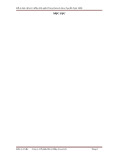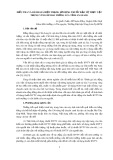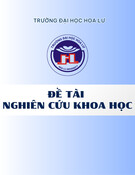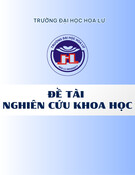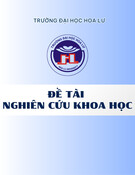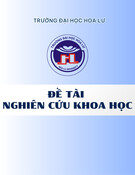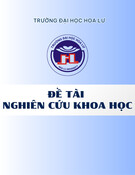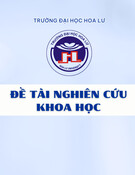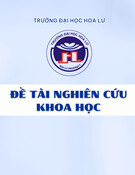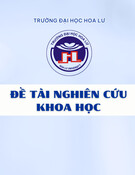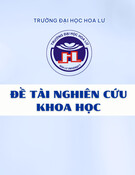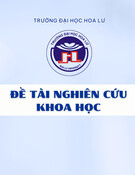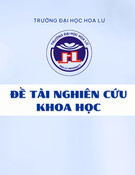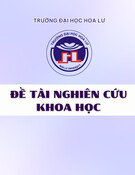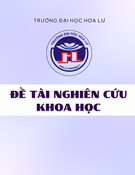
BioMed Central
Page 1 of 4
(page number not for citation purposes)
Journal of Circadian Rhythms
Open Access
Research
Temporal variation in the recovery from impairment in
adriamycin-induced wound healing in rats
Haluk Alagol1, Soykan Dinc1, Bilgen Basgut2 and Nurettin Abacioglu*2
Address: 1Department of General Surgery, Ankara Oncology Training and Research Hospital, Demetevler, Ankara, Turkey and 2Department of
Pharmacology, Gazi University, 06330, Hipodrom, Ankara, Turkey
Email: Haluk Alagol - halagol@gmail.com; Soykan Dinc - soykanege@gmail.com; Bilgen Basgut - bilgenh@gazi.edu.tr;
Nurettin Abacioglu* - nabaci@gazi.edu.tr
* Corresponding author
Abstract
Background: An adriamycin-induced impairment of wound healing has been demonstrated
experimentally in rats. The purpose of this study is to investigate a possible temporal variation in
recovery from the impairment of wound healing caused by adriamycin administration.
Methods: The subjects were 120 female Spraque-Dawley rats. They were divided into eight
groups, undergoing adriamycin administration (8 mg/kg, i.v.) at 9 a.m. or 9 p.m. on day 0 and
laparotomy on day 0, 7, 14 or 21. Blast pressures were recorded after the incision line had been
opened, and tissue samples were kept at -30°C for later measurement of hydroxyproline levels.
Results: Adriamycin treatment in rats at 9 p.m. resulted in significantly lower blast pressure levels
than treatment at 9 a.m. between days 7 and 21, indicating a lag effect of healing time in wounded
tissues. However the decreased hydroxyproline levels were not changed at these days and
sessions.
Conclusion: It is concluded that adriamycin-induced impairment of wound healing in adult female
rats exhibits nycthemeral variation.
Background
Surgical operation and chemotherapy are concurrent
applications in the treatment of various cancer cases. One
of the disadvantages of such a concomitant treatment is
retardation of healing time in the wounded tissues. The
lag effect of healing time of injured tissues is due to, and
interrelated with, the circadian dosing time, as dosing
time influences the extent of toxicity of some 30 antican-
cer drugs, including cytokines and cytostatics, in mice or
rats. Selection of the proper circadian dosing time maxi-
mizes efficacy and minimizes toxicity [1-3].
Adriamycin is a broad-spectrum anthracycline-derivative
intercalating agent with many clinical side effects. Adri-
amycin-induced impairment of wound healing was first
demonstrated by Devereaux et al. in rats [4,5], and many
Published: 10 October 2007
Journal of Circadian Rhythms 2007, 5:6 doi:10.1186/1740-3391-5-6
Received: 30 May 2007
Accepted: 10 October 2007
This article is available from: http://www.jcircadianrhythms.com/content/5/1/6
© 2007 Alagol et al; licensee BioMed Central Ltd.
This is an Open Access article distributed under the terms of the Creative Commons Attribution License (http://creativecommons.org/licenses/by/2.0),
which permits unrestricted use, distribution, and reproduction in any medium, provided the original work is properly cited.

Journal of Circadian Rhythms 2007, 5:6 http://www.jcircadianrhythms.com/content/5/1/6
Page 2 of 4
(page number not for citation purposes)
studies have been conducted since then to clarify the
mechanisms involved. It has been found that the wound-
healing impairment depends on direct inhibition of mito-
sis in local fibroblasts and keratinocytes or myelosuppres-
sion of platelets and inflammatory cells, which are
important in recovery from injury [6-8]. The toxicity and
efficacy of adriamycin can be modulated by the selection
of optimal dosing times in a chronotherapeutic manner
[9,10], as is the case for other drugs as well [11].
In a previous study, we showed that the optimal timing
for surgery after adriamycin treatment in rats is before the
7th day or after the 35th day [12]. The aim of the present
study is to investigate if there is a time-of-day effect on the
recovery time of adriamycin-induced wound-healing
impairment in rats.
Methods
Locally-bred female Spraque-Dawley rats – weighing
250–300 g, clinically healthy, non-pregnant, and non-lac-
tating – were used. Rats were kept in individual cages
under a light-dark cycle with 12 h of light per day (100 lux
illuminance, cool fluorescent bulbs, lights on from 8 a.m.
to 8 p.m.). Photosafe red bulbs were used to facilitate the
injections during the 12-h dark phase. In the pre- and
post-operative periods, animals were given a standard
commercial laboratory diet and water ad libitum. Proto-
cols of animal husbandry and experimentation followed
applicable regulations at the Gazi University Animal
Housing facilities. All experiments were performed during
the months of June and July to avoid the potential impact
of seasonal biological rhythms on the findings.
Experimental protocols
Administration of adriamycin and laparotomy
As summarized in Table 1, the initial pool of 120 rats was
divided into two equal groups based on the time of adri-
amycin administration (8 mg/kg i.v, Adriblastina, Deva,
ıstanbul, Turkey): either 9 a.m. or 9 p.m. Adriamycin was
administered only once on day 0 in both groups by injec-
tion into a dorsal tail vein under ether sedation. Each
group was subdivided into 4 subgroups depending on the
day of laparotomy (day 0, 7, 14, or 21). Laparotomies
were conducted under ketamine-xylasine anesthesia (100
mg/kg ketamine and 5 mg/kg xylasine) as a 4 cm midline
abdominal incision. The abdominal layers were closed
with 4/0 polypropylene matrix sutures (Prolene; Ethicon,
Edinburgh, UK).
Determination of blast pressure
Blast pressure was determined one week after the laparat-
omy. The animals were killed by excess ether anesthesia,
and the abdominal sutures were removed. An passage was
opened to the vaginal apex with the help of a lancet. A bal-
loon was inserted into the peritoneal cavity through the
incision and was filled with isotonic NaCl solution
infused at a constant rate of 20 ml/min. An intraluminal
pressure manometer attached to the apex of the balloon
measured pressure in mmHg (Bİçakçİlar, ıstanbul, Tur-
key). The pressure recorded at the time when the incision
line opened was considered the explosion pressure.
Measurement of hydroxyproline levels
A full layer of the abdominal wall in the laparotomy area,
2 cm from the skin edge, was collected and kept at -30°C
for the hydroxyproline evaluation. The enzyme levels
were evaluated by Bergman and Loxley's method [13]. The
hydroxyproline concentrations were evaluated as μg/mg
in the wet tissue.
Statistical analysis
The results are presented as the means ± standard error of
the means (SEM). Since the distributions of values were
normal and the variances were homogeneous, the light-
dark cycle mean values (i.e., temporal variation) of the
parameters were analyzed by one-way analysis of variance
(ANOVA) followed by the post-hoc Tukey-Kramer multi-
ple comparisons test. When the data did not follow a
Gaussian distribution as revealed by Barlett's test, the
Kruskal-Wallis test followed by the Dunns test for multi-
ple comparisons was used. Differences between time
groups were assessed by the unpaired Student's t-test
when necessary. A probability level of less than 0.05 was
considered to be statistically significant.
Results and Discussion
No rat died in the course of the study. Hyperemia, due to
adriamycin leakage around the dorsal line of tail vein, was
observed in one rat from the 1st group, two rats from the
4th group, one rat from the 6th group and one rat from the
7th group.
The mean blast pressures in groups 2, 4, 6, 8 (9 p.m.) were
significantly lower than in groups 1, 3, 5, 7 (9 a.m.) on
days 0, 7, 14, and 21 (Table 2). The simultaneous
decreases in hydroxyproline levels in the various groups
were not statistically different (Table 3).
Table 1: Setup of experimental rat groups
Adriamycin (8 mg/kg i.v.)
Laparotomy Day 9 a.m 9 p.m
0 Group 1 Group 2
7 Group 3 Group 4
14 Group 5 Group 6
21 Group 7 Group 8
Sample size for each groups n = 15.

Journal of Circadian Rhythms 2007, 5:6 http://www.jcircadianrhythms.com/content/5/1/6
Page 3 of 4
(page number not for citation purposes)
The multimodal approaches applied to improve recovery
after cancer treatment has expanded the boundaries of
oncological surgery. Many surgeons have to operate their
patients under active chemotherapy or they have to for-
ward their patients to adjuvant chemotherapy soon after
the operation. Multiple surgical interventions are usually
performed to investigate the efficiency of the debulking
surgery and the efficiency of antineoplastic recovery.
However, chemotherapy has negative effects on wound
healing [14].
Adriamycin is a chemotherapeutic agent of the anthracy-
cline group with wide-spectrum action. It is one of the
antineoplastics most often used. However, it has many
side effects. It may also be toxic to the injury under treat-
ment if applied preoperatively. It decreases the scar colla-
gen accumulation and so it decreases the injury tension
[15]. Many studies have been conducted in order to clarify
the reason for the effect of adriamycin on wound healing.
It has been recently shown that the effect on wound heal-
ing depends on the myelosuppressive effect of adriamycin
[16].
Our previous study showed that hydroxyproline levels
were decreased significantly 7, 14, 21, and 28 days after
adriamycin treatment, as compared with a control group.
On the contrary, hydroxyproline levels on day 0 and day
35 after adriamycin treatment were not changed. Accord-
ing to these results, we suggested that the optimal timing
for surgery after adriamycin treatment is after the 35th day
or before the 7th day, and surgery is not recommended
between the 14th and 28th days [12].
In the present study, the effect of adriamycin applied at
different times was evaluated. The reason for using blast
pressure was to investigate a relatively early period of the
injury recovery. On the other hand, in order to answer the
question as to the biological time-structure of the injury
recovery, we arranged the 9 a.m. and 9 p.m. groups.
In various studies, the measurement of hydroxyproline
level was used as thebiochemical parameter for injury
recovery. The decrease in the level of hydroxyproline cor-
responds to the decrease in the amount of collagen. In
many earlier studies, the anastomoses evaluation was
done in the intestines, and a decrease in hydroxyproline
level was found [17].
It is very natural to observe a postoperative decrease in the
hydroxyproline level depending on lysis of collagen in 2–
4 days. Due to the increase of the collagen synthesis, the
level of hydroxyproline may also increase. Many factors
such as infection, hypovolemia, prostaglandins, vitamin
A, aprotonin, statins, and the nutrition conditions can
affect the levels of hydroxyproline [18-23].
Total and dialyzable hydroxyproline excreted in urine is a
collagen-related proliferation marker in bone, cartilage,
soft tissue and skin [24]. Urinary excretion of dialysable
and non-dialysable hydroxyproline varies with age in rats
and exhibits diurnal fluctuations with minima and
maxima appearing at the end of the dark and light fraction
of the period, respectively [25]. The low hydroxyproline
levels seen in many studies support the inference of a con-
nection between deterioration of recovery from injury and
decreased collagen. Thus, both enzyme levels and colla-
gen formation must be considered in the evaluation of
injury recovery [17]. Collagen-induced proliferation in
wounded tissues displays enhanced mitotic activity in the
relevant cells as was shown in injured adult female rat rec-
tal epithelium with an exhibition of a diurnal variation
with maximal activity during the day and minimal activity
during the night [26].
Adriamycin exerts its effects by binding to nucleic acids,
cell membranes and plasma proteins, and by inhibiting
nucleic acid synthesis and mitotic activity. Most of these
effects were suggested to impair wound healing by directly
Table 2: Temporal variation induced by adriamycin (8 mg/kg,
i.v.) administration on blast pressure after laparotomy
Blast pressures (mmHg)
Laparotomy Day Injection times of adriamycin
9 a.m 9 p.m
0 112.5 ± 12.2* 101.8 ± 5.6
7 97.1 ± 4.2* 86.3 ± 6.3
14 79.1 ± 8.0* 65.1 ± 5.3
21 83.1 ± 3.7* 72.0 ± 3.1
Data represents the means ± S.E.M; Sample size for each group: n =
15.
* 9 a.m. vs 9 p.m. on same laparatomy days p ≤ 0.05
Table 3: Temporal variations induced by adriamycin (8 mg/kg,
i.v.) administration on hydroxyproline levels after laparotomy
Hydroxyproline (μg/mg wet tissue)
Laparotomy Day Injection times of adriamycin
9 a.m 9 p.m
0 7.0 ± 1.1 6.8 ± 0.9
7 5.7 ± 0.2 5.6 ± 0.2
14 5.9 ± 0.9 5.8 ± 0.9
21 5.7 ± 0.3 5.7 ± 0.4
Shown are means ± S.E.M. Sample size for each group n = 15. * 9 a.m.
vs 9 p.m. on same laparatomy days p ≤ 0.05

Journal of Circadian Rhythms 2007, 5:6 http://www.jcircadianrhythms.com/content/5/1/6
Page 4 of 4
(page number not for citation purposes)
inhibiting the mitosis of wound repair cells [7]. On the
other hand, the first studies in which the adriamycin was
used in 1977 showed that the decrease in tumor size fol-
lowing recovery from adriamycin in a transplanted plas-
macytoma of the rat was dependent on the application
time of the medicine [27]. In other words, when the ani-
mals were subjected to adriamycin soon before they woke
up at the end of their resting time, the fastest decrease in
tumor size was observed. In our study, the decrease in
blast pressure at night was found to be significant in all
groups, but a concurrent decrease in hydroxyproline levels
was not observed. We found that administration of adri-
amycin in the morning was more effective than adminis-
tration during the night.
Extrapolation of these findings to human patients must
take into consideration the fact that humans are diurnal
but rats are nocturnal. Adriamycin cancer chemotherapy
occurring in conjunction with therapeutic surgery must be
take into consideration the optimal time for adriamycin
administration with in order to increase efficacy and
reduce toxicity. It is expected that in human patients adri-
amycin treatment will have greater efficacy and lesser tox-
icity when administered in the evening.
Conclusion
Our results suggest that adriamycin-induced impairment
of wound healing could be ameliorated by administration
of the drug in the evening.
Competing interests
The author(s) declare that they have no competing inter-
est.
Authors' contributions
HA directed the study and participated in data collection.
SD participated in the design of the study. BB performed
statistical analysis and coordinated the participation of
the other contributors. NA directed the study, participated
in data collection, and wrote the final version of the man-
uscript. All authors read and appoved the final manu-
script.
References
1. Levi F: Chronotherapeutics: the relevance of timing in cancer
therapy. Cancer Causes Control 2006, 17:611-621.
2. Levi F: Chronopharmacology of anticancer agents. In Hand-
book of Experimental Pharmacology Vol. 125: Physiology and Pharmacology
of Biological Rhythms Edited by: Redfern P, Lemmer B. Springer-Verlag,
Berlin; 1997:299-331.
3. Granda TG, Filipski E, D'Attino RM, Vrignaud P, Anjo A, Bissery MC,
Lévi F: Experimental chronotherapy of mouse mammary
adenocarcinoma MA 13/C with docetaxel and doxorubicin as
single agents and in combination. Cancer Res 2001,
61:1996-2001.
4. Devereux DF, Thibalt L, Boretos J, Brennan MF: The quantitative
and qualitative impairment of wound healing by adriamycin.
Cancer 1979, 43:932-938.
5. Devereaux DF, Kent H, Brennan MF: Time dependent effects of
adriamycin and x-ray therapy on wound healing in the rat.
Cancer 1980, 45:2805-2810.
6. Lawrence W, Norton J, Harvey A, Gorschboth C, Talbot T, Groten-
dorst G: Doxorubicin-induced impairment of wound healing
in rats. J Natl Cancer Inst 1986, 76:119-126.
7. Curtsinger LJ, Pietsch JD, Brown GL, von Fraunhofer A, Ackerman D,
Polk HC Jr, Schultz GS: Reversal of Adriamycin-impaired
wound healing by transforming growth factor β. Surg Gynecol
Obstet 1989, 168(6):517-522.
8. Gulcelik M, Dinc S, Dinc M, Yenidogan E, Ustun E, Renda N, Alagol H:
Local granulocyte-macrophage colony-stimulating factor
improves incisional wound healing in adriamycin treated
rats. Surg Today 2006, 36:47-51.
9. Scheving LE, Burns ER, Pauly JE, Halberg F: Circadian bioperiodic
response of mice bearing advanced L1210 leukemia to com-
bination therapy with adriamycin and cyclophosphamide.
Cancer Res 1980, 40:1511-1515.
10. Burns ER: Circadian biological time influences the effect adri-
amycin has on DNA synthesis in mouse bone marrow, ileum,
and tongue but not Ehrlich ascites carcinoma. Oncology 1985,
42:384-387.
11. To H, Ohdo S, Shin M, Uchimaru H, Yukawa E, Higuchi S, Fujimura A,
Kobayashi E: Dosing time dependency of doxorubicin-induced
cardiotoxicity and bone marrow toxicity in rats. J Pharm Phar-
macol 2003, 55:803-810.
12. Gulcelik MA, Dinc S, Ersoz-Gulcelik N, Cetinkaya K, Caydere M,
Ustun H, Alagol H: Optimal timing for surgery after adriamy-
cin treatment in rats. Surg Today 2004, 34:1031-1034.
13. Bergman I, Loxley R: Two improved and simplified methods for
the spectrophotometric determination of hydroxyproline.
Ann Chem 1963, 35:1961-1965.
14. Falcone R, Nappi J: Chemotherapy and wound healing. Surg Clin
North Am 1984, 64(4):779-794.
15. DeCunzo LP, Mackenzie JW, Marafino BJ Jr, Devereux DF: The
effect of interleukin-2 administration on wound healing in
adriamycin-treated rats. J Surg Res 1990, 49(5):419-427.
16. Bauer G, O'Connel S, Devereux D: Reversal of doxorubicin-
impaired wound healing using triad compound. Am Surg 1994,
60(3):175-179.
17. Hendriks T, Mastboom WJ: Healing in experimental intestinal
anastomoses; parameters for repair. Dis Colon Rectum 1990,
33:891-901.
18. Brennan SS, Foster ME, Morgan A: Prostaglandins in colonic
anastomosic healing. Dis Colon Rectum 1984, 27:723-725.
19. Foster ME, Laycock JR, Silver IA: Hypovolemia and healing in
colonic anastomoses. Br J Surg 1985, 72:831-834.
20. Hesp FL, Hendriks T, Lubbers EJ: Wound healing in the intestinal
wall; effects of infection on experimental ileal and colonic
anastomoses. Dis Colon Rectum 1984, 27:462-467.
21. Van Zuidewijn DBWR, Wobbes T, Hendriks T: The effect of anti-
neoplastic agents on the healing of small intestinal anasto-
moses in the rat. Cancer 1986, 58:62-66.
22. Young HL, Wheeler MH: Collagenase inhibition in the healing
colon. J R Soc Med 1983, 76(1):32-36.
23. Witte K, Weisser K, Nembeck M: Cardiovascular effects, phar-
macokinetics, and converting enzyme inhibition of enalapril
after morning versus evening administration. Clin Pharmacol
Ther 1993, 54:177-186.
24. Seibel MJ: Biochemical markers of bone turnover part I: Bio-
chemistry and variability. Clin Biochem Rev 2005, 26:97-122.
25. Gaggi R, Gianni AM, Montanaro N: Dialysable and non-dialysable
hydroxyproline in the rat's urine: age related and diurnal var-
iations. J Physiol Lond 1982, 326:11-19.
26. Reeve DRE: A study of mitotic activity and the diurnal varia-
tion of the epithelial cells in wounded rectal mucous mem-
brane. J Anat 1975, 119(2):333-345.
27. Chabner BA, Myers CE, Oliverio VT: Clinical pharmacology of
anticancer drugs. Semin Oncol 1977, 4(2):165-91.

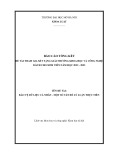
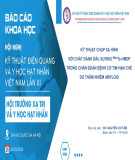

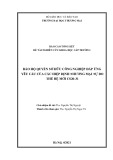
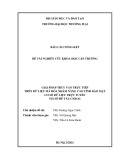
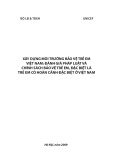
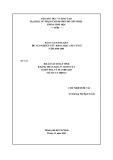
![Vaccine và ứng dụng: Bài tiểu luận [chuẩn SEO]](https://cdn.tailieu.vn/images/document/thumbnail/2016/20160519/3008140018/135x160/652005293.jpg)
